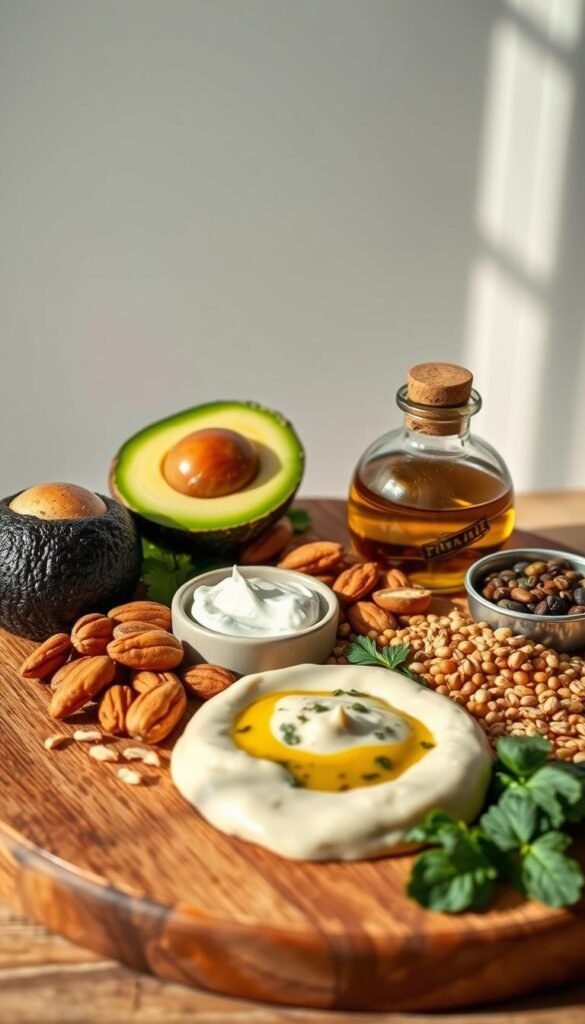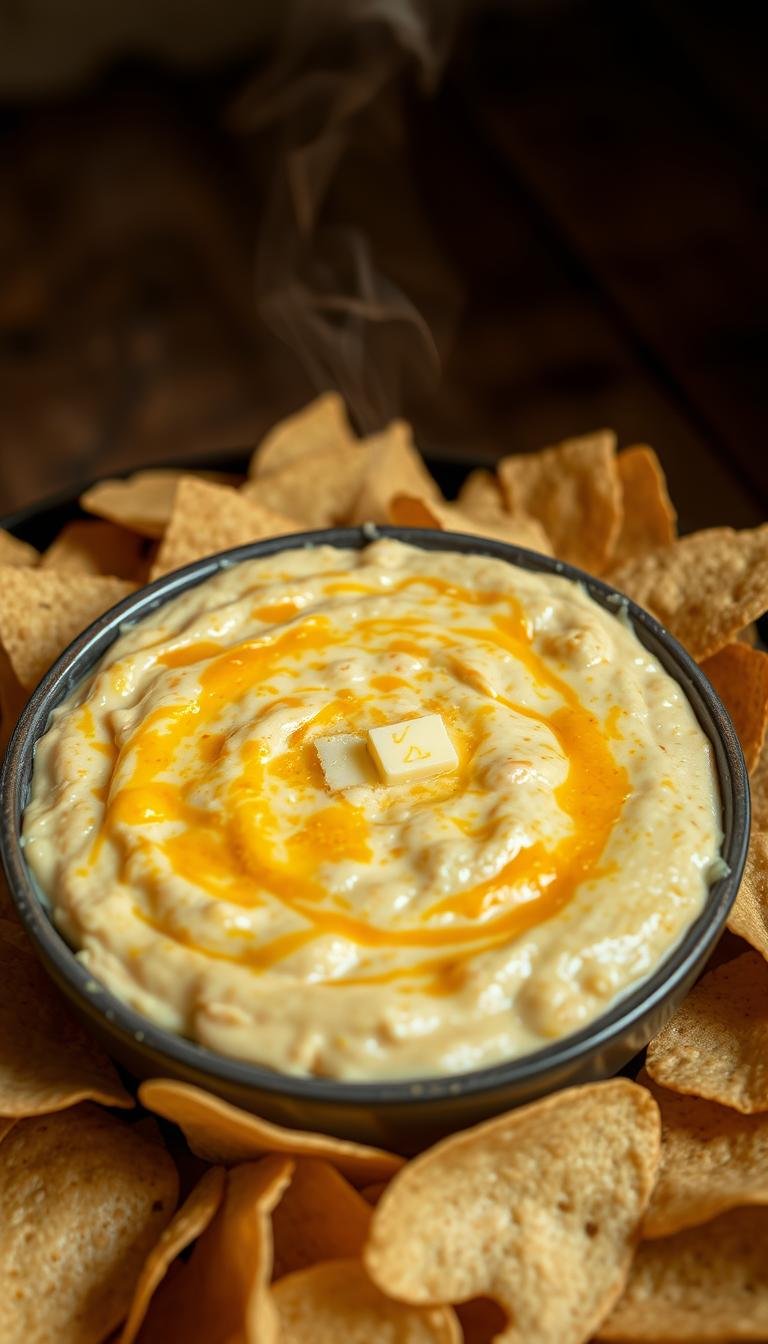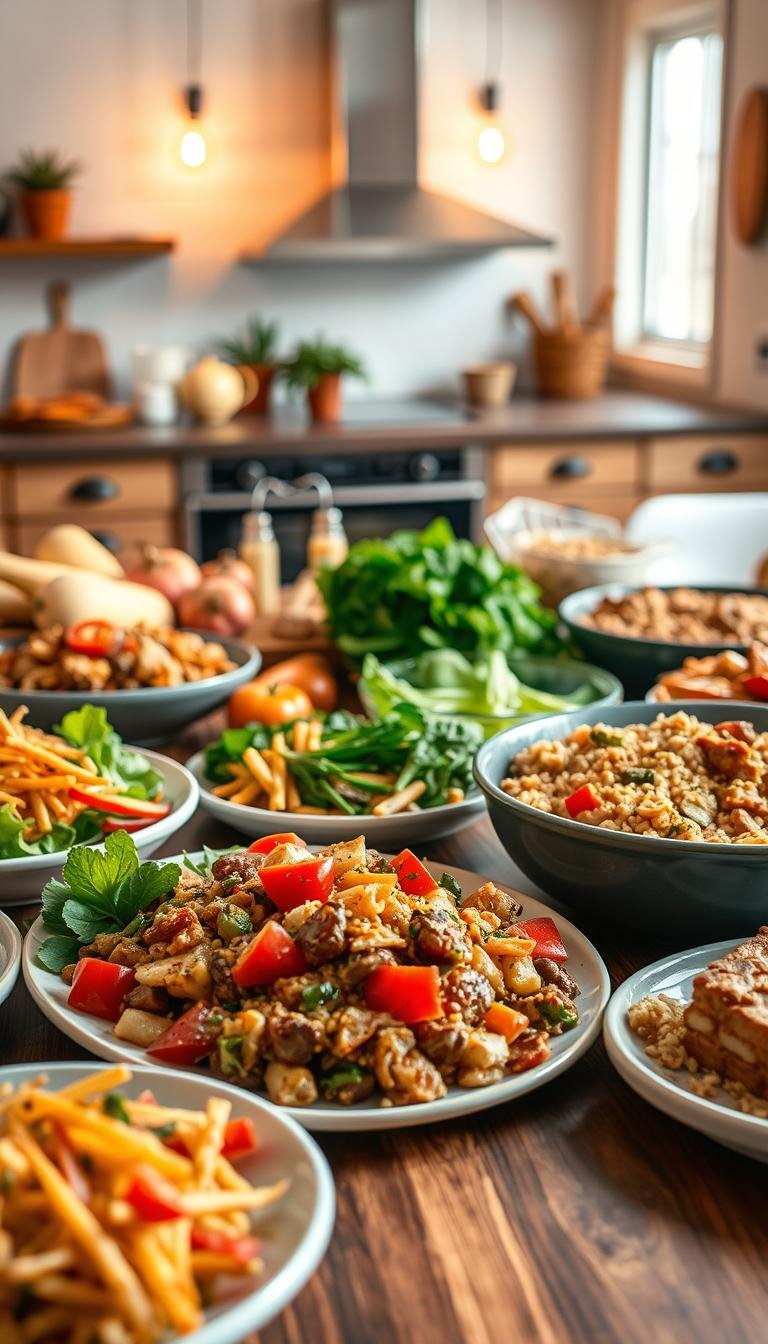5 Healthy Dip Recipes That Taste Amazing
Did you know Americans eat over 2 billion pounds of dips every year? With more people eating healthy, we want tasty dips that are good for us too.
By making homemade dips with good stuff, you can avoid bad stuff in store-bought ones. This way, you snack on nutritious dips that are safe and yummy.
This guide shows you 5 tasty and healthy dip recipes. They’re great for snacks, parties, or with meals. These healthy snacks are yummy and good for you.
Key Takeaways
- Discover simple and delicious healthy dip recipes.
- Learn how to make nutritious dips at home.
- Explore the benefits of homemade dips over store-bought options.
- Find healthy snacking solutions that are full of flavor.
- Enjoy guilt-free dips that are perfect for any occasion.
The Benefits of Healthy Homemade Dips
Making dips at home is great for your health and wallet. You pick the ingredients. This means you can make snacks that taste good and fit your diet.
Nutritional Advantages Over Store-Bought Options
Homemade dips are better for you than store-bought ones. Store-bought dips have preservatives, lots of sodium, and artificial stuff. Homemade dips use fresh ingredients, so they’re healthier.
For example, store-bought hummus might have sugar and preservatives. But homemade hummus has chickpeas, tahini, garlic, and lemon. It tastes better and is healthier.
- Less sodium
- Less preservatives
- No fake flavors or colors
- More nutrients from fresh ingredients
Customization Possibilities for Dietary Needs
Homemade dips are great because you can change them to fit your diet. You can make them gluten-free, dairy-free, vegan, or keto by picking the right ingredients.
This is super helpful for people with special diets. You can make dips that taste good and are right for your body. For instance, use plant-based stuff instead of dairy.
- Pick ingredients that fit your diet (like vegan yogurt or avocado)
- Change seasonings to avoid things you don’t like or can’t eat
- Try new spices and herbs to make it taste better
Cost-Effectiveness of Homemade Dips
Homemade dips are also cheaper than buying them. Ingredients like beans, veggies, and yogurt are cheap. They make a lot of dip.
For example, homemade hummus is cheap to make and gives lots of servings. A store-bought container might cost the same but has fewer servings. So, making dips at home saves money and is still tasty and healthy.
Essential Ingredients for Nutritious Dips
Making healthy dips is easy with the right ingredients. You can make dips that are tasty and good for you. The key is to mix the right stuff.
Protein-Rich Bases
Choosing a protein-rich base is important. Greek yogurt, legumes like chickpeas, cottage cheese, and tofu are great. They give you protein and help keep your blood sugar steady.
For example, Greek yogurt has good bacteria for your gut. Legumes are full of fiber and vitamins.
- Greek yogurt: High in protein and probiotics
- Legumes: Rich in fiber, vitamins, and minerals
- Cottage cheese: Excellent source of protein and calcium
- Tofu: Versatile and rich in protein
Healthy Fats and Their Importance
Adding healthy fats is key for dips. Avocados, olive oil, nuts, and seeds are full of good fats. Avocados are good for your heart, and nuts and seeds add crunch.

- Avocados: Rich in monounsaturated fats
- Olive oil: Excellent source of healthy fats
- Nuts and seeds: Provide crunch and healthy fats
Flavor Enhancers Without Added Sugar
You can make dips taste great without sugar or fake flavors. Use fresh herbs, spices, citrus juices, roasted vegetables, and fermented foods like miso. They add flavor and nutrients like antioxidants and vitamins.
- Fresh herbs: Add flavor and antioxidants
- Spices: Provide depth without added sugar
- Citrus juices: Enhance flavor with a burst of citrus
- Roasted vegetables: Add depth and nutrients
- Fermented foods: Rich in probiotics and flavor
5 Healthy Dip Recipes That Taste Amazing
Get ready to enjoy our 5 healthy dip recipes. They are both nutritious and full of flavor. These dips are perfect for any diet.
What Makes These Recipes Special
Our healthy dip recipe collection is special. It focuses on nutritious dip preparation. We use whole foods and smart flavor mixes.
Each recipe is made to be healthy and tasty. So, you can enjoy your favorite dips without feeling guilty.
Equipment You’ll Need
To make these best healthy dips, you need basic kitchen tools. You’ll need a food processor or blender for smooth dips. Also, mixing bowls and measuring tools are key.
Having storage containers is also important. They help keep your dips fresh. While some tools are nice, the basics will make delicious dips easy to make.

1. Classic Hummus with a Healthy Twist
We’re making a healthier version of the classic hummus. It’s still delicious but now it’s better for you. This dip is loved for good reasons, and we’ve made it even better.

Ingredients and Nutritional Profile
To make our healthy hummus, you need chickpeas, tahini, garlic, lemon juice, and a special ingredient. We use aquafaba to make it creamier and cut down on oil. Spinach or roasted red peppers add vitamins and antioxidants.
This hummus is packed with nutrients. It has protein and fiber from chickpeas, healthy fats from tahini, and vitamins from spinach or red peppers. A 2-tablespoon serving has about 100 calories, 5g of protein, 3g of healthy fats, and 8g of carbs.
Step-by-Step Preparation Guide
First, drain and rinse chickpeas, saving the aquafaba. If using fresh chickpeas, cook them until soft. Then, mix chickpeas, tahini, garlic, lemon juice, and your twist ingredient in a blender.
Blend until smooth, adding aquafaba as needed. Taste and adjust the seasoning. Put the hummus in a bowl and garnish with paprika, parsley, or chickpeas.
Serving Suggestions and Healthy Dippers
Our hummus is great with many things. Enjoy it with carrot, cucumber, or bell pepper sticks for a crunchy snack. You can also dip whole grain pita or seed crackers. For a bigger meal, use it as a spread or salad topping.
Variations to Try
Want to try something new? Add parsley or cilantro for a fresh taste, or a bit of cayenne for spice. Try using roasted beets or sweet potatoes for different flavors and nutrients.
Every variation brings a new taste while keeping the health benefits. Get creative and find your favorite mix!
2. Creamy Greek Yogurt Tzatziki
Explore the cool world of Greek yogurt tzatziki. It’s a tasty, healthy dip loved for ages. Its mix of taste and health keeps it popular.

Ingredients and Nutritional Profile
To make tasty tzatziki, you need a few things. You’ll need Greek yogurt, cucumber, garlic, and herbs like dill or parsley. You also need olive oil and lemon juice.
Choose full-fat yogurt for creaminess or low-fat for a lighter taste. For the cucumber, pick English or Persian types for their mild taste and less water.
Tzatziki is packed with protein from yogurt and has probiotics for your gut. It’s also low in calories.
Step-by-Step Preparation Guide
To make tzatziki, start by grating the cucumber and adding salt. This pulls out extra water. Wait 10-15 minutes, then squeeze out the water with cheesecloth or a fine-mesh sieve.
After, mix the cucumber with yogurt, garlic, herbs, olive oil, and lemon juice. Mix well and adjust the taste. Aim for a creamy but not too thick texture.
Serving Suggestions and Healthy Dippers
Tzatziki is great with veggies, grilled meats, and pita bread. But it’s also good as a sauce for chicken or fish, a dressing for bowls, or a sandwich spread.
For healthy dippers, try carrot sticks, cucumber slices, cherry tomatoes, or whole-grain pita chips. Tzatziki’s cool, creamy texture goes well with many flavors.
Variations to Try
Enjoy making tzatziki your own. Add avocado for creaminess or roast garlic for a deeper taste. Try different herbs like mint or basil for a unique flavor.
As chef and food writer,
“Tzatziki is more than just a dip; it’s a refreshing condiment that can elevate a wide range of dishes, from simple snacks to complex meals.”
This makes tzatziki a great addition to your cooking.
3. Avocado-Based Guacamole with Hidden Veggies
Our avocado-based guacamole is a hit with health lovers. It mixes creamy avocados with veggies for extra nutrition.
Nutritional Profile
Our guacamole is packed with good stuff. Avocados give it healthy fats, fiber, and vitamins. We add veggies like zucchini and spinach for more fiber and vitamins A and C.
| Nutrient | Amount per Serving | % Daily Value |
|---|---|---|
| Healthy Fats | 10g | 15% |
| Fiber | 7g | 28% |
| Vitamin C | 20mg | 33% |
| Vitamin A | 10mcg | 15% |
Step-by-Step Preparation Guide
It’s easy to make our guacamole. Pick ripe avocados by squeezing them. Then, grate or puree your veggies.
In a big bowl, mix avocado, veggies, lime juice, cilantro, and salt. Mash it all together until smooth.
To stop it from turning brown, add more lime juice. Then, cover it with plastic wrap, pressing it on the dip.
Serving Suggestions and Healthy Dippers
Our guacamole goes great with many healthy snacks. Try it with jicama, bell pepper, or endive. You can also use it on grain bowls or sandwiches.
- Jicama slices
- Bell pepper wedges
- Endive leaves
- Carrot sticks
Variations to Try
Want to spice up your guacamole? Try these ideas:
- Add diced mango or pineapple for a fruity twist.
- Change the spice by adding more or less jalapeño.
- Try different hidden veggies like beets or carrots.
These changes will keep your guacamole fresh and fun.
4. Black Bean and Corn Fiesta Dip
Try our Black Bean and Corn Fiesta Dip for a tasty and healthy snack. It’s full of nutrients and perfect for those who want a healthier option.
Ingredients and Nutritional Profile
This dip has black beans, corn, tomatoes, onions, peppers, lime juice, and spices. You can use fresh, frozen, or canned ingredients. Canned black beans are easy and still full of protein and fiber. Fresh corn adds a sweet crunch.
The dip is packed with protein and fiber. It’s great for vegetarians and vegans. Black beans help with digestion, and the veggies add important vitamins and minerals.
Step-by-Step Preparation Guide
To make the dip, start by roasting the corn. Then, drain and rinse the black beans. Chop the onions, peppers, and tomatoes.
Mix the roasted corn, black beans, and chopped veggies. Blend with lime juice and spices. Blend until smooth. For a fresher taste, make it just before serving or refrigerate it.
Serving Suggestions and Healthy Dippers
Enjoy the dip with baked tortilla chips, whole grain crackers, or plantain chips. You can also use fresh veggies. It’s great in stuffed peppers or taco bowls.
Variations to Try
Try adding avocado for creaminess or Greek yogurt for tanginess. Use different peppers to change the heat. These changes make the dip interesting and healthy.
5. Roasted Red Pepper and Walnut Dip
Try our Roasted Red Pepper and Walnut Dip for a taste of the Mediterranean. It’s a twist on muhammara. Sweet roasted red peppers and earthy walnuts make it special.
Ingredients and Nutritional Profile
This dip has roasted red peppers, walnuts, pomegranate molasses, and spices. Each adds health benefits. Peppers are full of vitamin C and antioxidants. Walnuts have omega-3s and antioxidants too.
The dip is good for your heart. It has healthy fats, antioxidants, and anti-inflammatory compounds. A 2-tablespoon serving has 100 calories, 9g fat, 1g protein, and 2g carbs.
Step-by-Step Preparation Guide
To make the dip, start by roasting red peppers. You can do this over an open flame or in the oven. Once charred, peel, remove seeds, and chop.
Then, toast walnuts in a skillet or oven until fragrant. This makes them taste better. Mix the peppers, walnuts, molasses, breadcrumbs, olive oil, and spices in a food processor. Blend until smooth, adjusting seasoning as needed.
Serving Suggestions and Healthy Dippers
This dip goes well with many things. Try it with pita bread, vegetable sticks, or as a wrap spread. For a real treat, use toasted pita or crackers.
Variations to Try
Make the dip your own by trying different nuts or adding roasted beets. Beets add color and nutrition. You can also change the spice by using different peppers or adding cumin.
Tips for Storing and Preserving Homemade Dips
To enjoy your homemade dips for longer, it’s key to know how to store them right. Dips add health and taste to meals. But, their life depends on storage. Good storage keeps them fresh, healthy, and tasty.
Proper Container Selection
First, pick the right container for your dips. Glass containers with tight-fitting lids are best. They don’t react with food and keep air out. This stops spoilage.
For dips like guacamole, pick a container that keeps air out. This stops browning. Silicone bags are also good for their flexibility and seal.
Refrigeration Guidelines
Refrigeration is key for short-term storage. Keep dips at 40°F (4°C) or below. Dairy dips last 3 to 5 days. Bean dips can last up to a week.
Avocado dips are more delicate, lasting 1 to 3 days. Always check for spoilage signs like bad smells or mold.
- Use airtight containers to prevent contamination and exposure to air.
- Label containers with the date they were made.
- Keep dips away from strong-smelling foods, as they can absorb odors.
Freezing Options for Batch Preparation
Freezing is great for longer storage for many dips. But, dips with lots of water or dairy might not be the same after thawing. Bean and high-fat dips freeze better.
To freeze, use airtight containers or bags. Leave some space for expansion. Thaw in the fridge or at room temperature. Stir well before serving. Frozen dips can last up to 3 months.
- Prepare dips in batches to save time and ensure freshness.
- Portion dips into smaller containers before freezing for easier thawing.
- Stir well after thawing to restore the dip’s original consistency.
Conclusion
Making healthy dips at home is a big win for those looking for nutritious snacking options. You can pick the right ingredients to enjoy tasty dips. This way, you get the healthy dip benefits you want.
The five recipes in this article highlight the homemade dip advantages. From classic hummus to new dips like roasted red pepper and walnut. These dips are not just yummy. They also help you eat well and might help with weight.
Adding these recipes to your daily meals helps you eat healthy without missing out. Try different versions and make your own dips. Switching to homemade dips is a smart move for better health and more fun in cooking.






